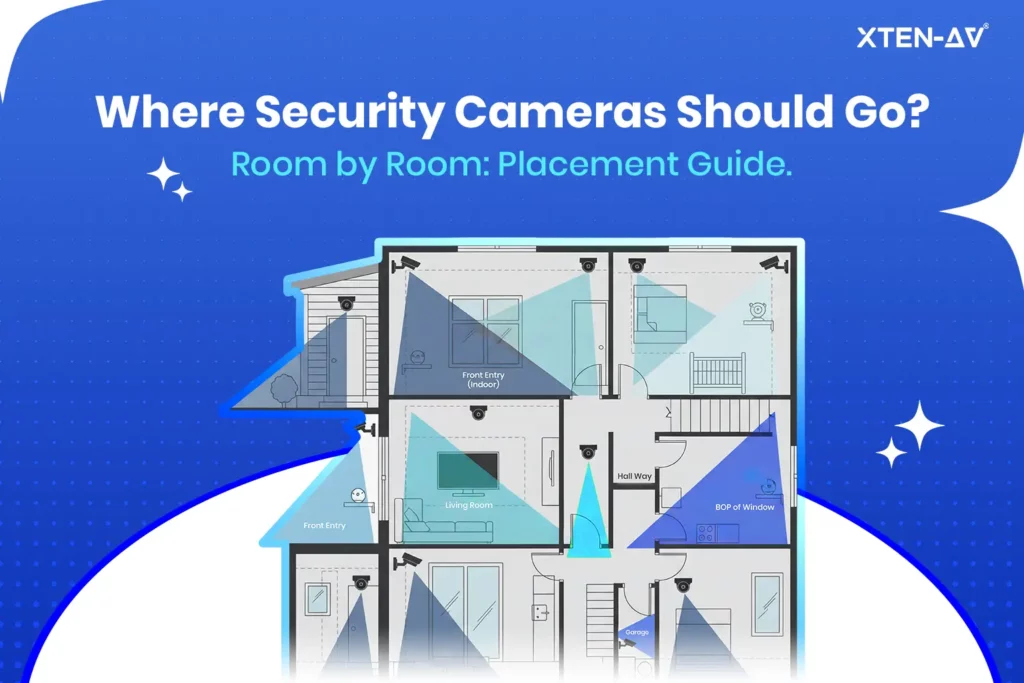Where Should The Placement of Security Cameras Be
Vibhav Singh
Published 22 September 2025
Finding the right security camera placement is just as important as choosing the camera itself. Even the best technology will not perform well if your security camera positioning leaves blind spots or misses key entry points.
Think about the areas that need the most attention. The front door should be at the top of your list, followed by back and side doors, which are often less visible from the street.
Driveways, garages, and any dimly lit paths or yards can benefit from added security camera coverage. Indoors, consider placing cameras in main living areas, hallways, and rooms that offer a clear view of entrances or areas of high traffic.
In this blog, you’ll find out exactly where to place your cameras for maximum security. You’ll learn how to balance indoor and outdoor positioning and what details to pay attention to when planning the setup. We’ll also go over some simple tips to avoid common installation mistakes so your system has full coverage with fewer blind spots. By the time you finish reading, you’ll know how to set up a network of cameras that performs almost like a professional installation.
Next, let’s look at how choosing the right cameras affects your indoor and outdoor coverage in the coming sections.
Key Takeaways:
- Careful security camera placement is as important as choosing the right camera. Poor positioning can leave blind spots.
- Use a security camera layout planner or security camera design tool to map coverage and find the best location for cameras.
- Focus on entry points, driveways, hallways, and high-traffic areas for full security camera coverage.
- Avoid obstructions, glare, and private indoor spaces when installing security cameras to ensure clear footage.
- Advanced tools like XTEN-AV’s X-DRAW, XAVIA, and X-DOC help plan, automate, and document your system efficiently.
The all-in-one solution for your AV needs
Transform your audio-visual experience with XTEN-AV.
No Credit Card required
How do you choose the right security camera for each area?
Okay, so, getting camera placement right kind of starts with choosing the right type of equipment. The camera you pick really, really affects how clear and reliable your footage will be, you know, so it’s worth thinking about the space first.
Outdoor cameras have to deal with rain, dust, and changes in light, so you kind of want one that can handle that stuff. Night vision is good too, since it lets you see even when it’s completely dark. For big spaces, like a driveway or backyard, a wide-angle lens usually helps cover more area. And for tighter spots, like a gate or walkway, a model with optical zoom gives you the detail you actually need.
Indoor security cameras need a different approach. You want cameras that fit in with the room so they don’t stand out, but still give sharp, high-definition video. Smaller cameras can make tampering less likely, and a lot of them have two-way audio so you can talk to anyone at the door. Motion alerts are handy too. They only record when something moves, which saves storage, and they help you notice and respond quickly if something seems off.
No matter which cameras you end up choosing, it really comes down to matching the right features with smart security camera placement. Try to watch for blind spots and get a good mix of indoor and outdoor coverage. If you do that, you’ll have a system that actually feels reliable and works the way you use your property in real life.
Where should you avoid placing security cameras (and why)?
Even the best equipment can underperform if your security camera placement is poor. Below are common mistakes to avoid when planning where to put CCTV cameras for maximum protection:
- Areas with poor lighting and no infrared capability
Cameras without night vision placed in dark corners will leave your property exposed after sunset, limiting overall security camera coverage.
- Directly facing bright light sources
Incorrect security camera positioning toward headlights, windows, or the sun creates glare and washed-out footage, making it hard to identify details.
- Blocked by trees, furniture, or décor
Any obstruction reduces the angle of view and creates blind spots, which defeats the purpose of installing security cameras.
- Too low or within easy reach
Mounting cameras at low levels makes them vulnerable to tampering or vandalism. Always install at a height that balances accessibility and security.
- Private indoor spaces
For home security camera placement, avoid bedrooms, bathrooms, or similar spaces. Beyond invading privacy, this can also violate local laws.
- Exposed to harsh weather without protection
Outdoor surveillance camera installation should always use weatherproof housing. Unprotected cameras are prone to water damage, dust, and reduced performance.
- Directly above entrances without a downward view
Many assume this is the best location for security cameras, but flat overhead placement often misses faces or entry details. A downward angle provides clearer identification.
A careful plan using a security camera layout planner or a security camera design tool like XTEN-AV’s X-Draw ensures that your indoor and outdoor cameras placement diagram avoids these pitfalls. Proper strategy leads to better coverage and fewer blind spots. Therefore, it makes your system far more reliable.
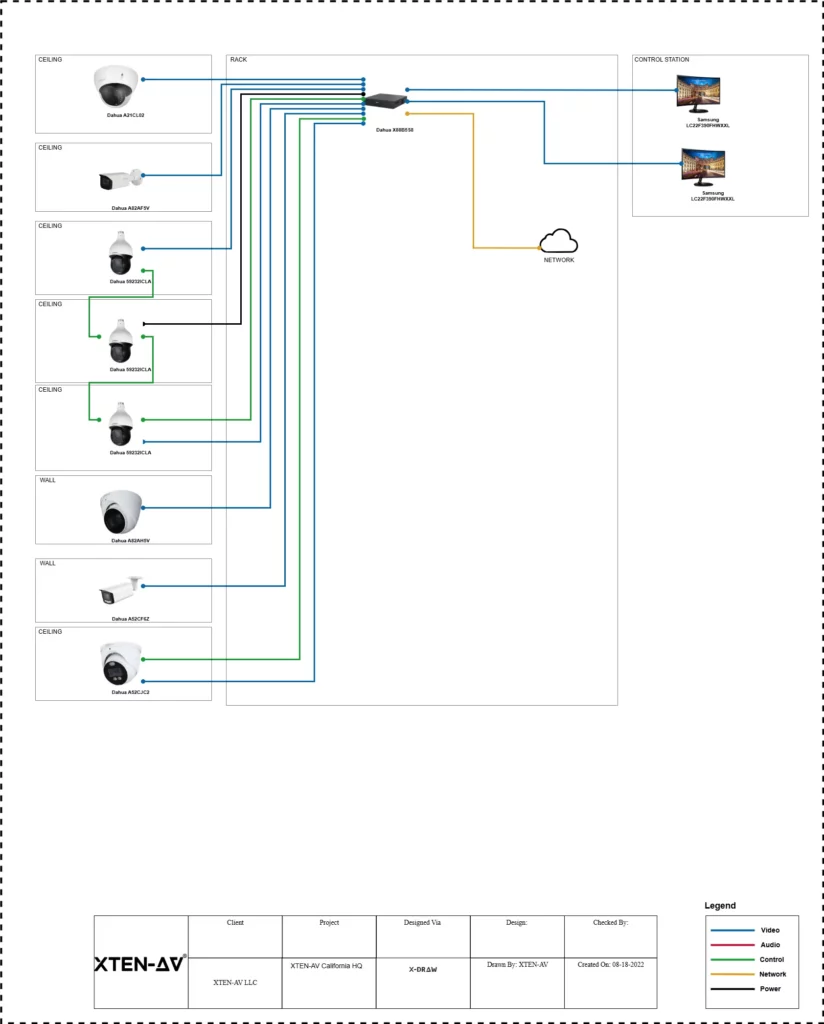
What are the best practices for security camera placement and use?
Getting the most out of your security system requires careful planning and smart execution. The following tips for placing and using security cameras can help maximize coverage and protect your property effectively:
- Plan before you mount – Start with a security camera layout planner or security camera design tool. This step helps you visualize coverage zones and ensures you identify the best location for security cameras before drilling or installing.
- Cover all entry points – Home security camera placement should always include front doors, back doors, side entrances, and ground-level windows. These are common access points and demand consistent monitoring.
- Optimize angle of view – Correct security camera positioning allows you to capture faces, license plates, and movements without distortion. Test different angles until you achieve a clear view.
- Use the right height – Mounting cameras around 8–10 feet high is recommended. This balances wide security camera coverage with reduced vulnerability to tampering.
- Blend indoor and outdoor coverage – A complete surveillance camera placement strategy combines indoor cameras for hallways or main rooms with outdoor surveillance camera installation for driveways, garages, and yards.
- Avoid obstructions – Position cameras away from trees, furniture, walls, or direct light glare. Obstructions create blind spots and reduce your security camera coverage.
- Leverage smart features – Motion detection, infrared night vision, and remote access tools strengthen the efficiency of surveillance camera placement.
- Review placement regularly – As your home or business layout changes, revisit your CCTV camera placement. Regular adjustments ensure consistent monitoring without gaps.
By following these proven tips for placing and using security cameras, you can design a reliable system that maximizes visibility, minimizes risks, and gives you peace of mind.
What security camera placement laws should homeowners and businesses know?
Before you start installing security cameras, it’s a good idea to get familiar with the laws in your area. Security camera placement has to follow privacy rules, which usually mean you can’t record places where people expect privacy, like bathrooms or bedrooms. For outdoor surveillance camera installation, some places even have rules about recording beyond your property, like a neighbor’s yard or their windows.
When you’re planning your CCTV camera placement, it helps to check both state and local guidelines so you don’t run into legal trouble. If you’re a business owner, there might be extra rules to follow for employee monitoring.
The best spots for security cameras are the ones that give you the coverage you need without stepping on anyone’s rights. Using a security camera layout planner or a security camera design tool can make planning a lot easier. It kind of makes sure your security camera positioning follows both safety and legal rules, and at the same time, it helps you get the most coverage from every camera.
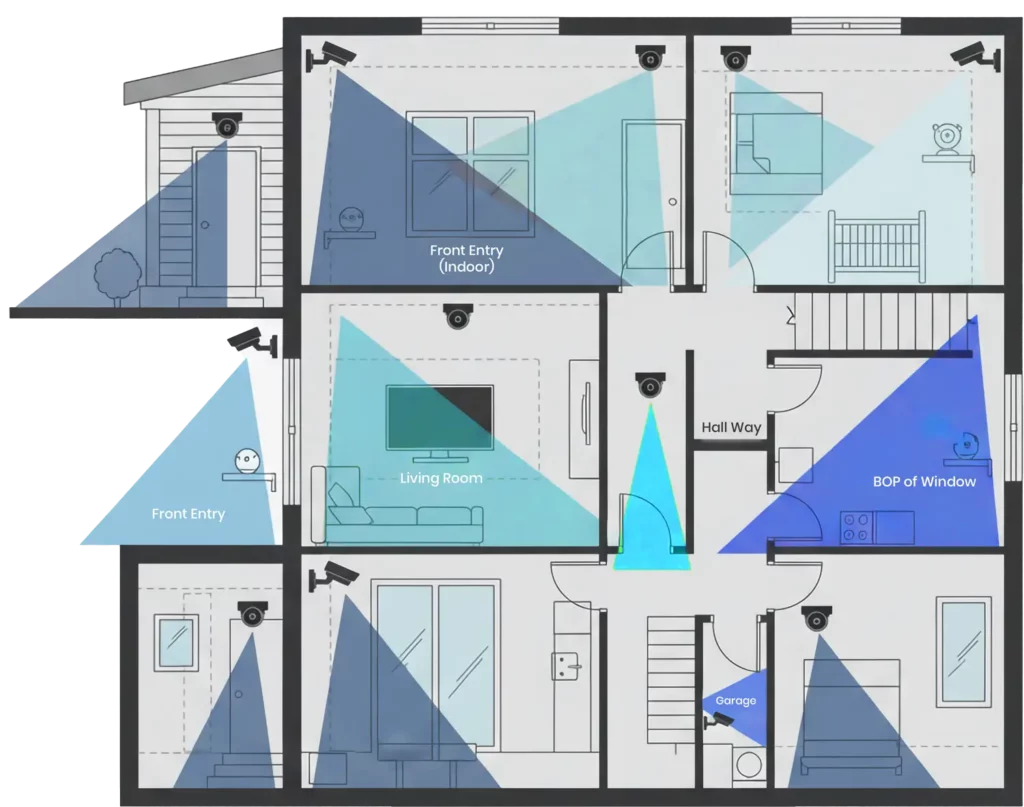
What common security camera placement mistakes hurt coverage and how do you fix them?
Even the best equipment can fall short if your security camera placement is poorly planned. One common error is mounting cameras too high or too low. If they are too high, details like faces or license plates can be hard to capture. If they are too low, they can be tampered with easily. The ideal mounting height is usually between eight and ten feet to balance coverage and security.
Another mistake is ignoring blind spots. Poor security camera positioning can leave vulnerable areas unmonitored, defeating the purpose of your system. Use a security camera placement tool to map your property and ensure full surveillance camera coverage.
Overlooking lighting conditions is also a frequent issue. Placing cameras where sunlight, headlights, or bright indoor lights shine directly into the lens can cause glare and distort footage.
For indoor spaces, avoid pointing cameras directly at reflective surfaces like mirrors or glass, as they can create glare and obscure details. Outdoors, ensure cameras are protected from harsh weather conditions and not blocked by trees, décor, or other obstructions.
Finally, many users forget to regularly review their CCTV camera placement. As landscaping, furniture, or property layouts change, so should your camera angles and positioning. A security camera design tool can help you recheck coverage, refine your home security camera placement. It also keeps your surveillance camera installation effective for both indoor and outdoor areas.
How XTEN-AV Simplifies Security Camera Placement and Documentation?
When it comes to planning surveillance, the challenge is not just in buying cameras but in ensuring they are placed, documented, and managed correctly. This is where XTEN-AV steps in with practical tools designed to simplify the entire workflow. This platform removes the guesswork from security camera placement by letting you create layouts/diagrams, proposals, and project documentation in a streamlined way.
X-DRAW, for instance, allows you to design a complete security camera layout digitally. Instead of struggling with manual sketches or worrying about blind spots, you can drag, drop, and map your cameras with accuracy. This helps in finding the best location for security cameras, both indoors and outdoors, while accounting for angles, obstructions, and lighting conditions.
Once the design is in place, XAVIA AI Agent takes it further by acting as an AI-powered assistant. It offers automated bill of materials, designs, proposal documentations and project management within minutes. All you have to do is enter a prompt through text or voice command and the generative AI (XTEN-AV’s AI agent) will handle the rest. For integrators, this means less time calculating and more time focusing on strategy.
Finally, when you’re ready to move from planning to execution, X-DOC generates detailed proposals and documentation. Instead of spending hours preparing paperwork, you can deliver clear, professional reports that clients understand.
By combining smart design with AI-driven insights, XTEN-AV ensures that your security camera system is not just installed but optimized. Whether you are securing a single home or managing a large facility, these tools make the process faster, sharper, and far more reliable.
The all-in-one solution for your AV needs
Transform your audio-visual experience with XTEN-AV.
No Credit Card required
AV Design Mastery + Winning Proposals = 10x Productivity!
- ✔ Automatic Cable Labeling & Styling
- ✔100+ Free Proposal Templates
- ✔ Upload & Create Floor Plans
- ✔1.5M Products from 5200 Brands
- ✔ AI-powered ‘Search Sense'
- ✔Legally Binding Digital Signatures
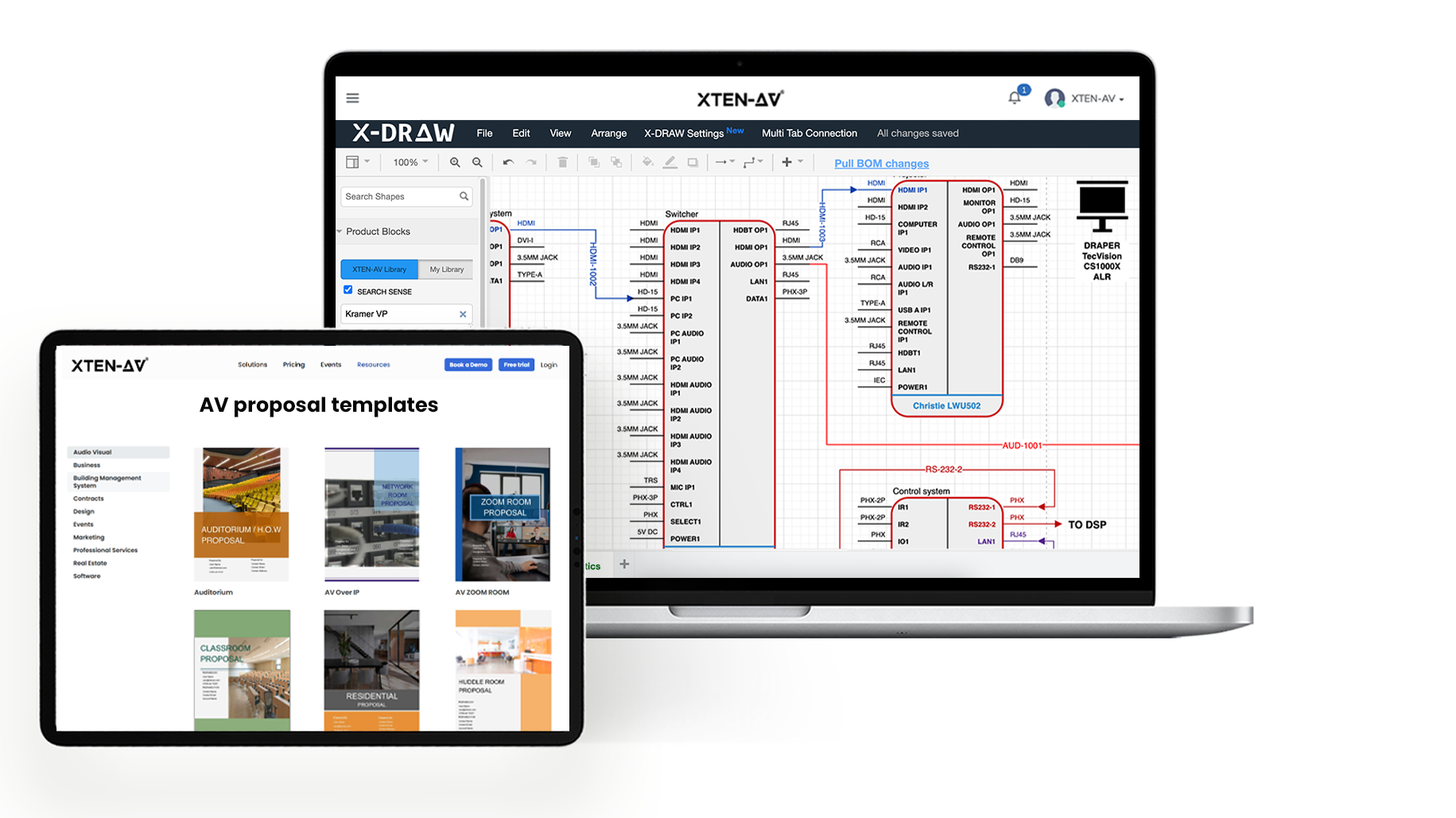
Conclusion
Placing security cameras in the right spots is about more than just putting them where they “look right.” It requires planning, the right tools, and an understanding of how each camera’s field of view works in your specific space. When you take time to plan your security camera placement carefully, you reduce blind spots and improve overall coverage. This also makes sure your system captures clear, useful footage when it matters most.
From avoiding common mistakes to understanding the legal boundaries of surveillance camera installation, every step plays a role in creating a secure environment. Whether you are setting up cameras indoors or outdoors, good positioning and consistent review will keep your system performing at its best.
Using advanced resources like XTEN-AV’s X-Draw security camera design tool can make the process faster and more precise. With a well-planned diagram and the right positioning, your security cameras can provide reliable protection year after year.
Sign up for a free 15-day trial or schedule a live demo with our experts, now!
FAQ's
Yes, indoor and outdoor security camera placement requires different approaches. Outdoor cameras must handle weather, wide angles of view, and areas like driveways, entrances, or backyards. Indoor cameras, on the other hand, should focus on hallways, common rooms, and access points. Proper security camera positioning ensures both settings deliver strong coverage. Using a security camera design tool helps balance indoor and outdoor placement for a complete surveillance camera installation.
Professional surveillance camera installation is not always required. Many modern systems are designed for DIY use with simple mounting options. However, professionals may be helpful if you are setting up a large system or integrating it with alarms and access control. A security camera layout planner can guide you on where to place CCTV cameras, making DIY placement easier while still achieving reliable security camera coverage.
A single camera can cover more than one area, but only if the angle of view is wide enough and the security camera positioning is correct. For example, a wide-angle lens might capture both a driveway and a front yard. Still, relying on one device for large areas can create blind spots. A security camera design tool can help test coverage and determine if additional cameras are needed for full protection.
You should review your home security camera placement at least once a year or whenever changes occur around your property. New fences, trees, furniture, or renovations can block the angle of view and reduce coverage. Regular checks ensure that your CCTV camera placement continues to meet your needs. Updating your surveillance camera installation with a layout planner ensures your system keeps up with changes indoors and outdoors.
Certain features improve surveillance camera placement results and reduce the number of cameras you need. Wide-angle lenses, pan-tilt-zoom options, and motion detection extend security camera coverage. For outdoor mounting, infrared or night vision ensures visibility in low light. Indoors, two-way audio and high-definition recording provide better detail. Pairing these features with thoughtful security camera positioning and a design tool helps create a reliable, full-coverage security camera layout.
Explore more by topic
AV Design Mastery + Winning Proposals = 10x Productivity!
- Automatic Cable Labeling & Styling
- 100+ Free Proposal Templates
- Upload & Create Floor Plans
- 1.5M Products from 5200 Brands
- AI-powered ‘Search Sense'
- Legally Binding Digital Signatures
No Credit Card Required
Related Blogs

-
- Posted by Sahil Dhingra
Audio Visual Security Site Survey for System Design & Integration Checklist Sahil...
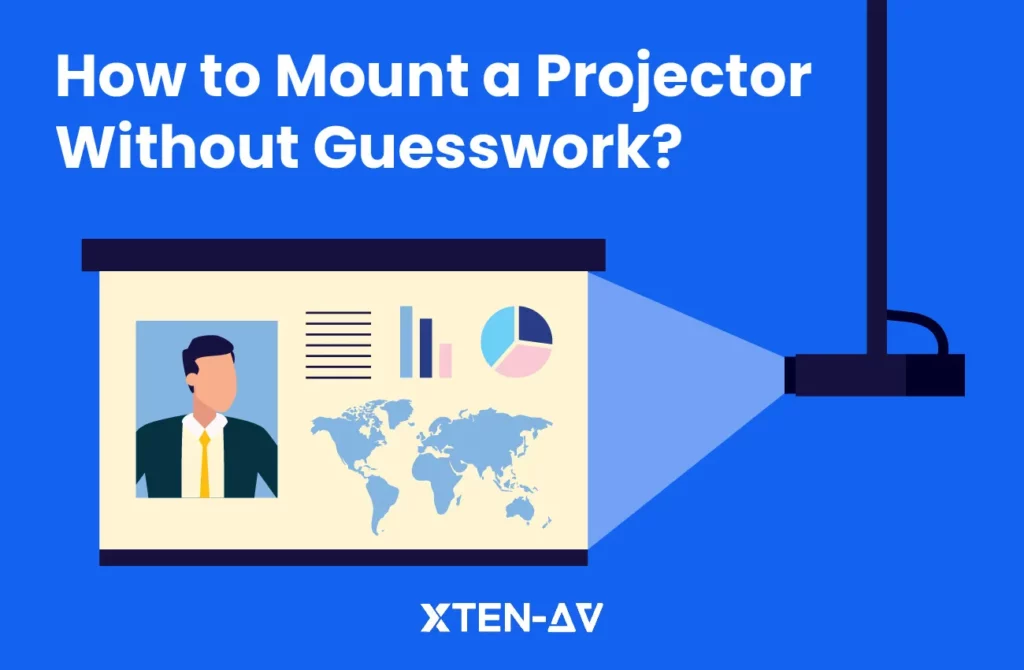
-
- Posted by Sahil Dhingra
Audio Visual How to Mount a Projector Without Guesswork Vibhav Singh Published...

-
- Posted by Sahil Dhingra
XTEN-AV Black Friday and Cyber Monday Deals in 2025 For Audio Visual...
